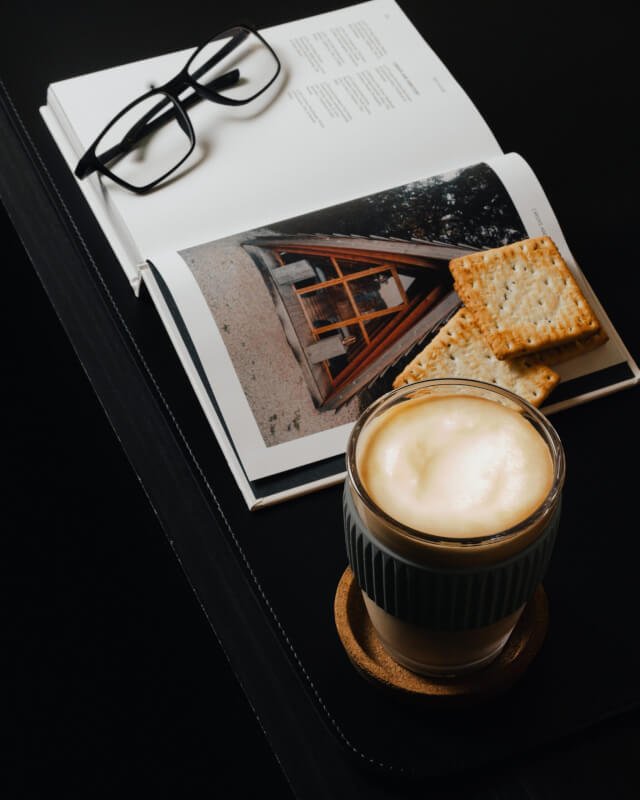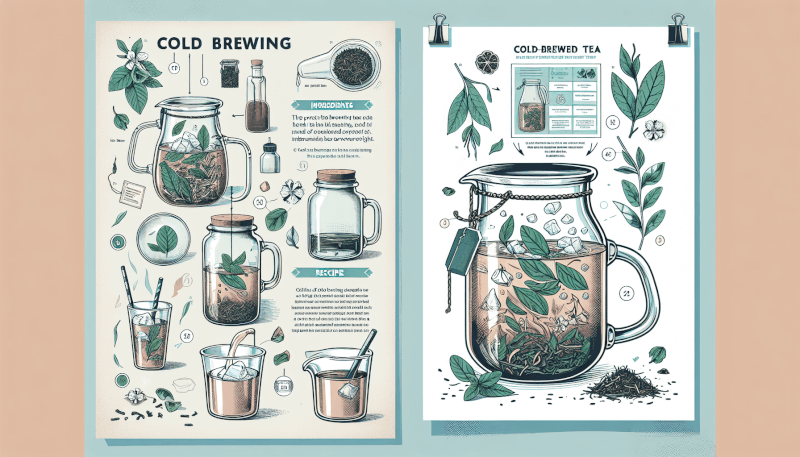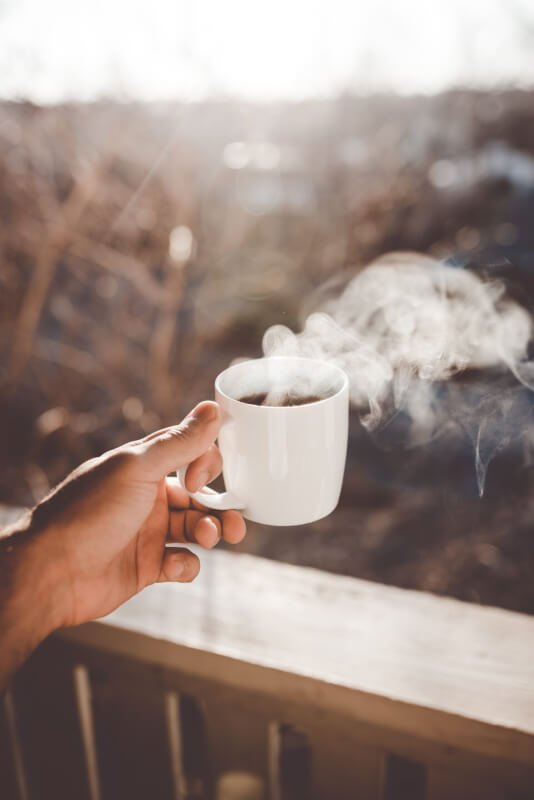Imagine sitting on your porch on a warm summer day, sipping a refreshing glass of iced tea. Now, picture that tea brewed to perfection, with its flavors subtly infused and its taste perfectly balanced. If you want to unlock the secret of making the most flavorful and delicious cold-brewed tea, then look no further. In this expert guide, we will walk you through the simple steps of cold brewing tea, ensuring that every sip you take is a refreshing delight.

Choosing the Right Tea
Selecting the Tea Leaves
When it comes to choosing the right tea, selecting the perfect tea leaves is crucial. There are countless varieties available, each with its own unique flavor and characteristics. Whether you prefer black tea, green tea, oolong tea, or herbal tea, take the time to explore different options and discover what appeals to your taste buds. Pay attention to the origin of the tea leaves and how they are harvested and processed, as these factors can greatly impact the flavor profile of your brewed tea.
Consider the Flavor Profiles
Tea offers a wide range of flavors, from bold and robust to delicate and floral. Before making your selection, think about the taste experience you desire. If you enjoy a strong and assertive brew, opt for black tea or certain varieties of green tea. If you prefer a lighter and more floral flavor, consider white or green teas with a delicate aroma. Herbal teas, on the other hand, can provide a vast array of flavors, including fruity, spicy, or minty. Experiment with different teas and pay attention to the flavor profiles that appeal to you the most.
Deciding on Caffeine Content
Tea contains caffeine, although the amount can vary depending on the type of tea leaves and how they are processed. If you are sensitive to caffeine or prefer to limit your intake, there are various options available. Herbal teas are naturally caffeine-free and offer a wide selection of flavors without the stimulating effects. Additionally, some green tea varieties and white teas have lower caffeine content compared to black tea. Consider your personal preferences and caffeine tolerance when choosing the right tea for your cold brew.
Equipment and Ingredients
Tea Leaves
Of course, the star ingredient in any cold brew tea is the tea leaves themselves. Ensure that you use high-quality tea leaves to achieve the best results. Loose leaf tea is often favored over tea bags, as it allows for better infusion and flavor extraction. Look for teas that are specifically labeled as suitable for cold brewing, as they are usually less processed and more delicate in flavor. There are countless online retailers and local specialty tea shops that offer a wide variety of high-quality tea leaves to choose from.
Water
Water is an essential component of any tea, and the quality of your water can greatly impact the taste of your cold brew. It is recommended to use filtered or spring water to ensure the purest taste. Avoid using tap water, as it may contain impurities or chemicals that can alter the flavor of your tea. The water temperature is also important, as different types of tea require specific temperatures. Invest in a reliable kettle with temperature control to ensure you can heat the water to the appropriate temperature for your chosen tea.
Brewing Vessel
Choosing the right brewing vessel is key to a successful cold brew. Glass pitchers or jars are popular choices because they allow you to see the infusion process and ensure that no residue or flavors are transferred. Avoid using plastic containers, as they may contain chemicals that can leach into your tea. Some brewing vessels come with built-in infusers or filters, which can make straining the tea leaves easier. If your brewing vessel does not have an infuser, you can use a separate tea strainer or even a simple cheesecloth to remove the tea leaves after brewing.
Additional Flavorings
While tea is delicious on its own, you can also enhance its flavor by adding additional ingredients. Fruits such as citrus slices, berries, or peaches can add a refreshing and natural sweetness to your cold brew. You can also experiment with herbs like mint or basil, which can provide a delightful aroma and subtle flavor. Spices such as cinnamon, ginger, or cardamom can add warmth and complexity to your tea. Get creative with your flavor combinations and find what suits your taste preferences.

Water Temperature and Ratios
Understanding Optimal Temperature
Different types of tea require different water temperatures to achieve the best flavor extraction. Green tea, for example, is generally brewed at lower temperatures ranging from 160°F to 180°F (71°C to 82°C), while black tea is typically brewed at higher temperatures between 190°F to 212°F (88°C to 100°C). Consult the packaging or do some research to determine the optimal temperature for your chosen tea. Investing in a digital thermometer or an electric kettle with temperature control can help ensure accuracy when heating the water.
Determining the Tea-to-Water Ratio
The ratio of tea leaves to water is another crucial factor in achieving the perfect cold brew. The general guideline is to use approximately 1 to 1.5 teaspoons of loose leaf tea per 8-ounce (240 ml) cup of water. However, this can be adjusted based on personal preference and the strength of flavor you desire. If you like a stronger brew, increase the amount of tea leaves. Conversely, if you prefer a milder flavor, decrease the amount of tea leaves. It is important to note that certain teas, like herbal teas, may require slightly different ratios due to their unique characteristics.
Experimenting with Temperature and Ratios
Part of the fun of cold brewing tea is experimenting with different temperature and ratio combinations to find your perfect brew. Start with the recommended temperature and tea-to-water ratio, and then adjust based on your personal taste preferences. If you find that a particular tea is too bitter or strong, try reducing the steeping time or decreasing the amount of tea leaves. Similarly, if you feel that the flavor is too weak, increase the steeping time or add a bit more tea leaves. Keep a record of your experiments so you can recreate your favorite cold brew recipes in the future.
Cold Brewing Methods
Traditional Cold Brew Method
The traditional cold brew method involves steeping tea leaves in cold or room temperature water for an extended period, typically between 6 and 12 hours. This slow and gentle process allows the tea leaves to slowly release their flavors, resulting in a smooth and less bitter brew. To cold brew using this method, simply combine tea leaves and cold water in a brewing vessel, cover it, and let it steep in the refrigerator for the desired duration. Once the steeping time is complete, strain the tea leaves and enjoy your refreshing cold brew at any time.
Mason Jar Method
The mason jar method is a convenient way to cold brew tea, especially if you want to make a larger batch to enjoy throughout the day. Simply add tea leaves and cold water to a clean mason jar. Secure the lid tightly and gently shake the jar to ensure the leaves are well-distributed in the water. Place the jar in the refrigerator and let it steep for the recommended time, typically 6 to 12 hours. Once the steeping is complete, strain the tea leaves and transfer the cold brew to a serving pitcher or individual cups.
Japanese Iced Tea Method
Originating from Japan, the Japanese iced tea method is well-suited for green teas, which are traditionally consumed cold. To prepare green tea using this method, start by pre-chilling your brewing vessel by filling it with ice cubes. Add the desired amount of tea leaves to a separate pitcher and pour hot water over the leaves, following the optimal temperature for your chosen tea. Let the tea steep for a short time, typically no longer than 2 minutes, to avoid bitterness. Once the steeping is complete, pour the tea into the chilled brewing vessel with ice cubes, diluting it to your desired strength. Stir gently and serve immediately for a refreshing and vibrant iced tea experience.

Steeping Time
Recommended Steeping Time
The recommended steeping time for cold brew tea varies depending on the type of tea and personal preference. As a general guideline, most black teas require a steeping time of 6 to 12 hours, while green and white teas typically require 4 to 8 hours. Herbal teas, on the other hand, can be steeped for a longer duration, ranging from 8 to 24 hours. It is important to experiment with different steeping times to find the flavor profile that suits your taste. Keep in mind that longer steeping times can result in a stronger and more robust brew, while shorter steeping times may yield a milder taste.
Adjusting Steeping Time for Personal Preference
If you find that your cold brew tea is too strong or bitter, you can decrease the steeping time to achieve a milder flavor. Similarly, if you prefer a more intense brew, you can increase the steeping time. Remember to take note of the steeping time that yields your preferred taste, as it can vary depending on the type of tea, tea-to-water ratio, and personal preference. Adjusting the steeping time allows you to fine-tune the flavor profile and ensure that each cup of cold brew tea is tailored to your liking.
Straining and Filtering
Removing Tea Leaves or Bags
After the steeping process is complete, it is essential to strain and remove the tea leaves or tea bags to prevent over-extraction and bitterness. If you are using loose leaf tea, a tea steeper, infuser, or tea strainer can be used to separate the leaves from the liquid. Gently pour the brewed tea through the strainer into a separate container, pressing on the tea leaves to extract any remaining liquid. If you are using tea bags, simply remove them from the brewing vessel and discard them. Properly straining your cold brew tea ensures a clean and smooth texture.
Using a Fine-Mesh Strainer
For an extra level of filtration, a fine-mesh strainer can be used to remove any lingering tea particles and provide an even smoother texture. Simply place the fine-mesh strainer over the container or cup in which you will be serving your cold brew tea. Pour the strained tea through the strainer, allowing it to catch any small particles that may have passed through the initial straining process. This step can be particularly useful if you prefer a completely clear and sediment-free cold brew tea. Experiment with different filtration methods to find the one that suits your preference.

Infusing with Additional Flavors
Adding Fruits and Citrus
One of the joys of cold brew tea is the ability to infuse it with additional flavors to create a truly unique and refreshing beverage. Adding fruits and citrus can provide a burst of natural sweetness and a tangy twist to your cold brew tea. Consider adding slices of lemon, lime, or orange to your tea during the steeping process to infuse it with zesty flavors. You can also experiment with berries like strawberries, raspberries, or blueberries to add a subtle sweetness. Allow the flavors to meld together during the steeping time, and strain the tea before serving to enjoy a deliciously fruity cold brew.
Incorporating Herbs and Spices
Herbs and spices offer another layer of complexity and aroma to your cold brew tea. Mint leaves, for example, can lend a refreshing and cooling sensation, making them a popular choice for warm summer days. Basil leaves can add a unique herbal twist, while a touch of ginger can provide a warming and spicy element to the blend. Cinnamon sticks, cardamom pods, or star anise can create a comforting and aromatic infusion. Feel free to experiment with different herbs and spices to find the combinations that enhance the flavor of your chosen tea.
Storing and Serving
Proper Storage Techniques
Once you have prepared your cold brew tea, it is important to store it properly to maintain its freshness and flavor. Transfer the cold brew to a clean and airtight container, such as a glass pitcher or jar, and refrigerate it. Cold brew tea can be stored in the refrigerator for up to several days, depending on the type of tea and any additional flavorings used. However, it is best to consume it within 2-3 days to ensure optimal taste. Avoid leaving the tea at room temperature for extended periods, as this can lead to spoilage and a decline in flavor quality.
Serving Suggestions and Presentation
When it comes to serving cold brew tea, the options are endless. You can pour it over ice cubes for a refreshing and chilled beverage. For an elegant touch, garnish the glass with a slice of fruit or a sprig of mint. If you prefer a more elevated presentation, use a clear glass to showcase the beautiful color of your cold brew tea. Cold brew tea can also be diluted with sparkling water or soda for a fizzy and effervescent twist. Get creative with your serving suggestions and presentation to impress your guests or simply elevate your daily tea-drinking experience.

Health Benefits
Understanding the Antioxidant Properties
Tea, including cold brew tea, is known for its rich antioxidant properties. Antioxidants help protect the body against free radicals, which are unstable molecules that can cause damage to cells and contribute to various health issues. Cold brew tea, in particular, is often praised for its high concentration of antioxidants, as the gentle brewing process can help preserve the beneficial compounds found in tea leaves. By incorporating cold brew tea into your routine, you can enjoy a delicious beverage while reaping the potential health benefits associated with antioxidants.
Promoting Hydration and Wellness
Staying hydrated is essential for overall health and well-being, and cold brew tea can be a flavorful and enjoyable way to achieve this. Drinking cold brew tea throughout the day can help keep you hydrated and quench your thirst, especially during hot summer months or after physical activity. Furthermore, different types of tea offer various wellness benefits. For example, green tea is often lauded for its potential metabolism-boosting and weight management effects, while herbal teas are known for their calming and soothing properties. Incorporating cold brew tea into your lifestyle can enhance your hydration routine and support your overall wellness.
Experimenting with Recipes
Creating Unique Flavor Combinations
Cold brew tea provides the perfect canvas for creating unique and delicious flavor combinations. The possibilities are endless, and you can let your creativity run wild when experimenting with different ingredients. For a tropical twist, try combining green tea with fresh pineapple and a hint of coconut. For a festive and fragrant blend, consider infusing black tea with cinnamon, orange zest, and cloves. You can also take inspiration from classic cocktails and transform them into a refreshing cold brew tea. The only limit is your imagination, so don’t be afraid to explore and create your own signature cold brew tea recipes.
Exploring Different Tea Types
One of the delights of cold brew tea is the opportunity to explore different tea types and expand your palate. From earthy and robust black teas to delicate and floral white teas, there is a wide array of options to choose from. Venture beyond your comfort zone and try teas that you may not have considered before. Sample the nuances of green teas, discover the complexity of oolongs, or savor the refreshing flavors of herbal teas. By exploring different tea types, you can broaden your knowledge and appreciation for the world of tea while enjoying the versatility and freshness of cold brew methods.
In conclusion, choosing the right tea, understanding the equipment and ingredients, experimenting with water temperature and ratios, exploring cold brewing methods, mastering steeping time, straining and filtering techniques, infusing additional flavors, storing and serving suggestions, recognizing the health benefits, and embracing creativity with recipes are all essential aspects of becoming a cold brew tea enthusiast. With a bit of knowledge, experimentation, and a sense of adventure, you can embark on a delightful journey of discovering and enjoying the refreshing and flavorful world of cold brew tea. So go ahead, grab your favorite tea leaves, and start brewing your perfect, crisp, and invigorating cup of cold brew tea today!


